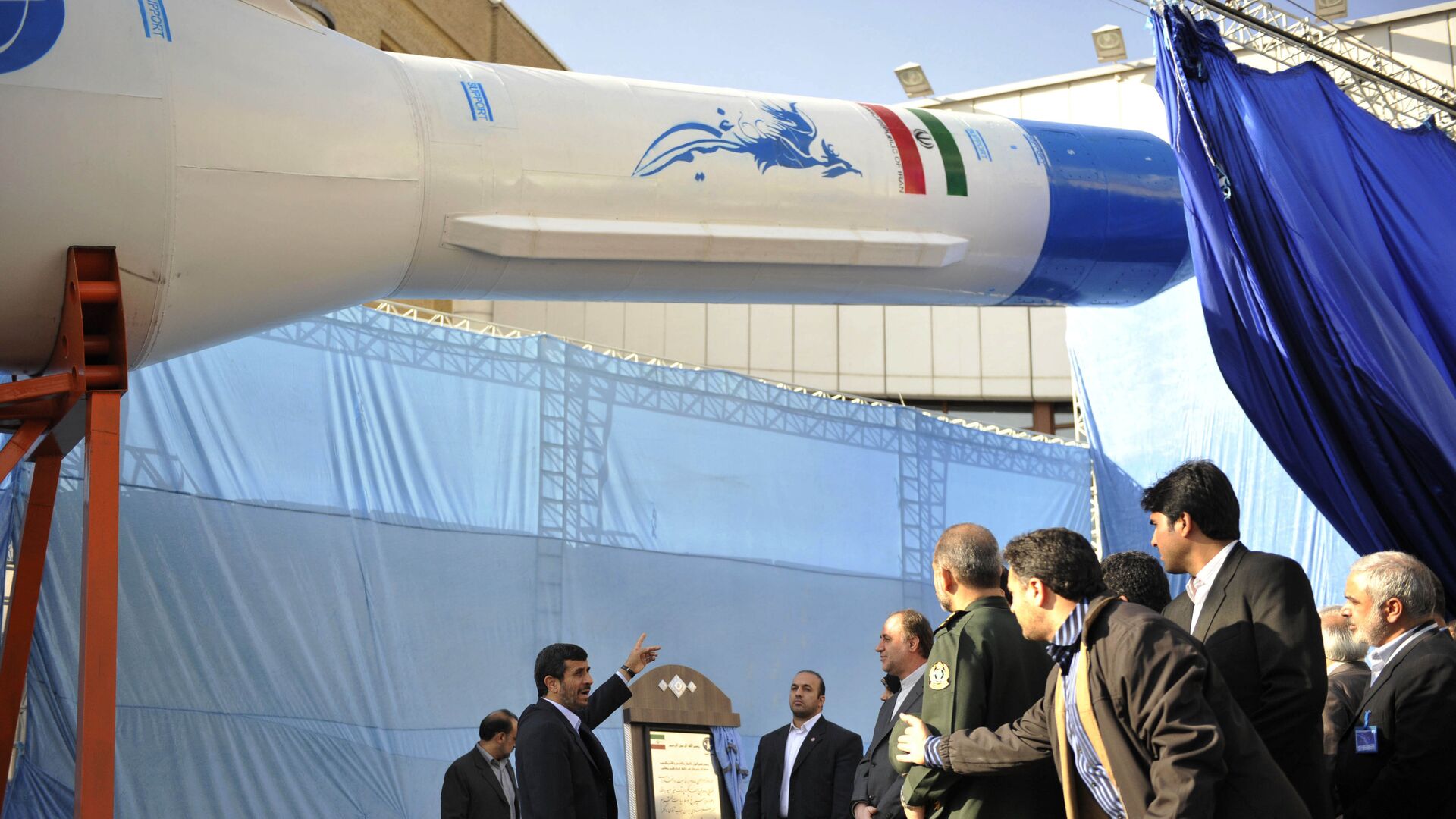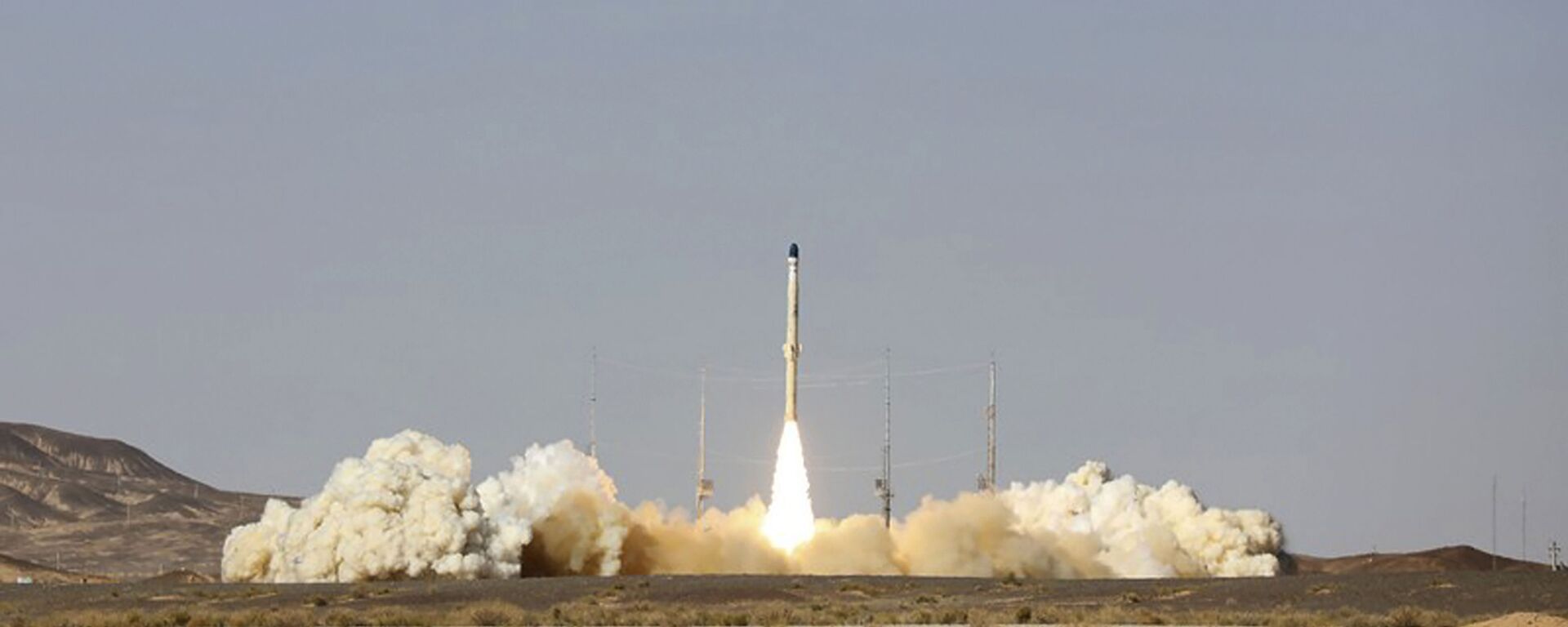https://sputnikglobe.com/20211230/iran-launches-three-new-satellites-into-low-earth-orbit-1091912618.html
Iran Launches Three New Satellites Into Low Earth Orbit
Iran Launches Three New Satellites Into Low Earth Orbit
Sputnik International
Tehran has launched a rocket carrying three satellites into space, Iranian Defence Ministry spokesman Ahmad Hosseini has revealed. According to him, a domestically developed Simorgh small orbital space launch rocket was used to send three research satellites to low Earth orbit at an altitude of 470 kilometres.
2021-12-30T10:42+0000
2021-12-30T10:42+0000
2023-04-12T16:57+0000
world
iran
satellite
space
https://cdn1.img.sputnikglobe.com/img/105592/75/1055927531_0:0:4256:2395_1920x0_80_0_0_37c241554a83dba07bb7d5e5014c69c0.jpg
Tehran has launched a rocket carrying three satellites into space, Iranian Defence Ministry spokesman Ahmad Hosseini has revealed. According to him, a domestically developed Simorgh small orbital space launch rocket was used to send three research satellites to low Earth orbit at an altitude of 470 kilometres.The official did not disclose the names or the nature of the satellites launched. It was also not clear whether they successfully reached their designated altitude and stayed in orbit.The Islamic Republic News Agency (IRNA) reported earlier in December that Tehran was preparing to launch four different satellites in the near future - Zafar 2, Pars 1, Nahid 1, and Nahid 2. Zafar 2 is an heir to an earlier model called Zafar 1 that was launched two years ago using a Simorgh rocket, but which had failed to stay in orbit.Zafar was designed to capture satellite images of Earth and send them back to Iran. The Nahid are reportedly telecommunications satellites. The Pars 1 satellite is equipped with a high-resolution 15-metre camera to capture images of Iranian lands, forests, and lakes to help the country's agricultural sector as well as to monitor various hazards, such as floods and wildfires.The US has condemned Iran's satellite launches in the past - even when the space cargo was civilian in nature. Right now, Washington is engaged in talks with Tehran in Vienna as the two attempt to restore the Iran nuclear deal – a 2015 international accord, which the US abandoned in 2018 slapping the Islamic Republic with sanctions. Tehran responded by ramping up its nuclear programme activities in violation of the nuclear accord. Now, Iran and the US are negotiating their mutual return to compliance with the nuclear deal, but the talks have so far yielded no results.
https://sputnikglobe.com/20210623/fake-news-alert-iran-dismisses-cnn-report-about-possible-failed-satellite-launch-1083223283.html
iran
Sputnik International
feedback@sputniknews.com
+74956456601
MIA „Rosiya Segodnya“
2021
Tim Korso
https://cdn1.img.sputnikglobe.com/img/07e6/03/0d/1093831826_0:0:216:216_100x100_80_0_0_e3f43a960af0c6c99f7eb8ccbf5f812c.jpg
Tim Korso
https://cdn1.img.sputnikglobe.com/img/07e6/03/0d/1093831826_0:0:216:216_100x100_80_0_0_e3f43a960af0c6c99f7eb8ccbf5f812c.jpg
News
en_EN
Sputnik International
feedback@sputniknews.com
+74956456601
MIA „Rosiya Segodnya“
Sputnik International
feedback@sputniknews.com
+74956456601
MIA „Rosiya Segodnya“
Tim Korso
https://cdn1.img.sputnikglobe.com/img/07e6/03/0d/1093831826_0:0:216:216_100x100_80_0_0_e3f43a960af0c6c99f7eb8ccbf5f812c.jpg
iranian space program, iranian satellite, satellite launch
iranian space program, iranian satellite, satellite launch
Iran Launches Three New Satellites Into Low Earth Orbit
10:42 GMT 30.12.2021 (Updated: 16:57 GMT 12.04.2023) Earlier in December, a state news agency reported that four satellites were undergoing final preparations for launch. One of them was set to replace a satellite launched two years ago, but which had failed to stay in orbit.
Tehran has launched a rocket carrying three satellites into space, Iranian Defence Ministry spokesman Ahmad Hosseini has revealed. According to him, a domestically developed Simorgh small orbital space launch rocket was used to send three research satellites to low Earth orbit at an altitude of 470 kilometres.
"In this launch, the performance of the space centre and the performance of the satellite carrier were adequate and finally, the intended research goals of this launch were achieved", Ahmad Hosseini stated.
The official did not disclose the names or the nature of the satellites launched. It was also not clear whether they successfully reached their designated altitude and stayed in orbit.
The
Islamic Republic News Agency (IRNA) reported earlier in December that
Tehran was preparing to launch four different satellites in the near future - Zafar 2, Pars 1, Nahid 1, and Nahid 2. Zafar 2 is an heir to an earlier model called Zafar 1 that was launched two years ago using a Simorgh rocket, but which had failed to stay in orbit.
Zafar was designed to capture satellite images of Earth and send them back to Iran. The Nahid are reportedly telecommunications satellites. The Pars 1 satellite is equipped with a high-resolution 15-metre camera to capture images of Iranian lands, forests, and lakes to help the country's agricultural sector as well as to monitor various hazards, such as floods and wildfires.
The
US has condemned Iran's satellite launches in the past - even when the space cargo was civilian in nature. Right now, Washington is engaged in talks with Tehran in Vienna as the two attempt to restore the Iran nuclear deal – a 2015 international accord, which the US abandoned in 2018 slapping the Islamic Republic with sanctions. Tehran responded by ramping up its nuclear programme activities in violation of the nuclear accord. Now, Iran and the US are negotiating their mutual return to compliance with the nuclear deal, but the talks have so far yielded no results.







